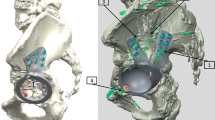Abstract
Background: Hip arthroplasty is one of the most frequently performed orthopedic procedures with high scores of success while its most common complication is aseptic loosening of the acetabular component, which may result from host bone loss or even from pelvis discontinuity. The purpose of the study was to evaluate results in patients after revision acetabular arthroplasty with reconstruction rings and allografts.
Materials and Methods: Retrospective data was collected from 69 revisions of acetabular components, performed in a group of 69 treated patients (the mean age 65.1 years). Before surgery, the patients had bone defects of type IIb (n = 5), IIc (n = 20), IIIa (n = 27) or IIIb (n = 17), according to Paprosky et al.
Results: The mean followup period of the patients was 7.2 years (range 3–19 years). A Kaplan-Meier analysis showed that a 3- and 10 year survival rate was 92.8% and 84.8% respectively, using further revision for any reason of the acetabular device as an end point. Eight patients revealed implant related complications. Four patients presented with ring loosening, one with a loose acetabular polyethylene cup, two hips demonstrated recurrent dislocations and one patient was with deep infection. Regarding the remaining 61 patients without re-revision surgery, the mean Harris hip score improved from 30.5 to 73.8 points.
Conclusion: A modified, antiprotrusion cage provides an acceptable survival rate and radiological results, but complications could still be expected. It seems that the observed massive bone loss with pelvic discontinuity and an insufficient fixation of the cage to the ischium may result in implant loosening. Stable fixation of the ischial ring flange with screws is an essential condition to expect a good outcome.
Similar content being viewed by others
References
Synder M, Drobniewski M, Sibinski M. Long term results of cementless hip arthroplasty with ceramic-on-ceramic articulation. Int Orthop 2012;36:2225–9.
Paprosky WG, Perona PG, Lawrence JM. Acetabular defect classification and surgical reconstruction in revision arthroplasty. A 6-year followup evaluation. J Arthroplasty 1994;9:33–44.
Bal BS, Maurer T, Harris WH. Revision of the acetabular component without cement after a previous acetabular reconstruction with use of a bulk femoral head graft in patients who had congenital dislocation or dysplasia. A followup note. J Bone Joint Surg Am 1999;81:1703–6.
Schlegel UJ, Bitsch RG, Pritsch M, Clauss M, Mau H, Breusch SJ. Mueller reinforcement rings in acetabular revision: Outcome in 164 hips followed for 2–17 years. Acta Orthop 2006;77:234–41.
Oakes DA, Cabanela ME. Impaction bone grafting for revision hip arthroplasty: Biology and clinical applications. J Am Acad Orthop Surg 2006;14:620–8.
Harris WH. Traumatic arthritis of the hip after dislocation and acetabular fractures: Treatment by mold arthroplasty. An end-result study using a new method of result evaluation. J Bone Joint Surg Am 1969;51:737–55.
DeLee JG, Charnley J. Radiological demarcation of cemented sockets in total hip replacement. Clin Orthop Relat Res 1976;20–32.
Kaplan EL, Meier P. Nonparametric estimation from incomplete observations. J Am Stat Assoc 1958;53:457–81.
Crockarell JR Jr. Intermediate-term results with a modified antiprotrusio cage in acetabular revision surgery. Am J Orthop (Belle Mead NJ) 2009;38:E144–8.
Goodman S, Saastamoinen H, Shasha N, Gross A. Complications of ilioischial reconstruction rings in revision total hip arthroplasty. J Arthroplasty 2004;19:436–46.
Jones L, Grammatopoulos G, Singer G. The Burch-Schneider cage: 9-year survival in Paprosky type 3 acetabular defects. Clinical and radiological followup. Hip Int 2012;22:28–34.
Peters CL, Curtain M, Samuelson KM. Acetabular revision with the Burch-Schnieder antiprotrusio cage and cancellous allograft bone. J Arthroplasty 1995;10:307–12.
Pieringer H, Auersperg V, Böhler N. Reconstruction of severe acetabular bone-deficiency: The Burch-Schneider antiprotrusio cage in primary and revision total hip arthroplasty. J Arthroplasty 2006;21:489–96.
Regis D, Magnan B, Sandri A, Bartolozzi P. Long term results of anti-protrusion cage and massive allografts for the management of periprosthetic acetabular bone loss. J Arthroplasty 2008;23:826–32.
Schatzker J, Wong MK. Acetabular revision. The role of rings and cages. Clin Orthop Relat Res 1999;187–97.
Symeonides PP, Petsatodes GE, Pournaras JD, Kapetanos GA, Christodoulou AG, Marougiannis DJ. The Effectiveness of the Burch-Schneider antiprotrusio cage for acetabular bone deficiency: Five to twenty-one years’ followup. J Arthroplasty 2009;24:168–74.
Udomkiat P, Dorr LD, Won YY, Longjohn D, Wan Z. Technical factors for success with metal ring acetabular reconstruction. J Arthroplasty 2001;16:961–9.
van Koeveringe AJ, Ochsner PE. Revision cup arthroplasty using Burch-Schneider anti-protrusio cage. Int Orthop 2002;26:291–5.
Volkmann R, Bretschneider K, Erlekampf E, Weller S. Revision surgery in high grade acetabular defects with thermodisinfected allografts. Z Orthop Unfall 2007;145 Suppl 1:S44–8.
Winter E, Piert M, Volkmann R, Maurer F, Eingartner C, Weise K, et al. Allogeneic cancellous bone graft and a Burch-Schneider ring for acetabular reconstruction in revision hip arthroplasty. J Bone Joint Surg Am 2001;83-A:862–7.
Kosashvili Y, Safir O, Backstein D, Lakstein D, Gross AE. Salvage of failed acetabular cages by nonbuttressed trabecular metal cups. Clin Orthop Relat Res 2010;468:466–71.
Author information
Authors and Affiliations
Corresponding author
Rights and permissions
About this article
Cite this article
Kmieć, K., Dorman, T., Andrzej, G. et al. Early results of revision acetabular cup using antiprotrusio reconstruction rings and allografts. IJOO 49, 317–322 (2015). https://doi.org/10.4103/0019-5413.156205
Published:
Issue Date:
DOI: https://doi.org/10.4103/0019-5413.156205




